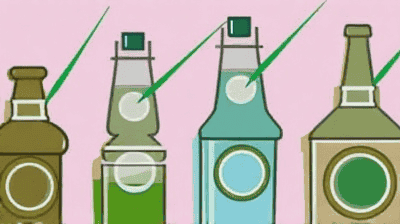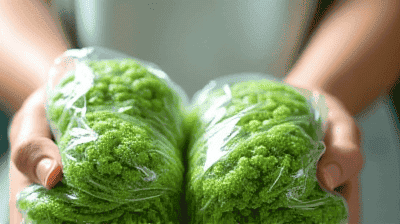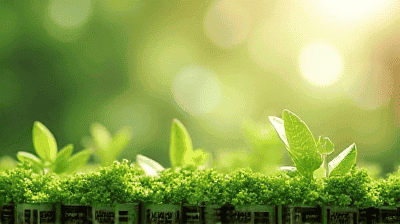
In recent years, the surge in plastic pollution has ignited a global conversation about sustainable alternatives to conventional plastics. Amid this discourse, bioplastics have emerged as a potential solution, touted for their ability to reduce environmental impact and reliance on fossil fuels. Made from renewable resources such as plants, bioplastics are often presented as an environmentally friendly alternative to traditional plastics derived from petrochemicals. However, the question remains: are bioplastics genuinely better for the environment?
Bioplastics are a diverse family of materials that can be categorized based on their origin and biodegradability. They can be made from renewable biological sources, like corn starch, sugarcane, or potato starch, or can be synthesized through chemical processes involving biomass. Bioplastics can also be classified into two main types:
Non-Biodegradable Bioplastics: These bioplastics are made from renewable resources but do not break down easily in the environment. An example of this type is polyethylene made from bioethanol derived from sugarcane.
Biodegradable Plastics: These types of plastics can break down into natural substances through the action of living organisms. Common examples include polylactic acid (PLA) and polyhydroxyalkanoates (PHA).
Understanding the differences between these categories is essential for assessing the environmental impact of bioplastics.
The production process of bioplastics differs from that of conventional plastics in several key ways. Most bioplastics are derived from renewable resources, which can provide a more sustainable feedstock compared to fossil fuels. However, the production techniques still involve complex chemical processes that may offset some environmental benefits.
Feedstock Cultivation: The agricultural practices used to grow the feedstocks for bioplastics can significantly impact the environment. Intensive farming can lead to habitat destruction, soil degradation, and increased pesticide use.
Processing: The conversion of biomass into bioplastics often involves energy-intensive processes, and the environmental footprint is influenced by the energy sources used in manufacturing.
Transportation: The logistics of transporting raw materials to manufacturing facilities, as well as the finished products to markets, contribute to the overall environmental impact.
Several types of bioplastics are commonly used today, each with its unique properties and applications:
Polylactic Acid (PLA): Derived from fermented plant starch (usually corn or sugarcane), PLA is a popular biodegradable plastic. It is often used in packaging, disposable cutlery, and 3D printing applications.
Polyhydroxyalkanoates (PHA): These are produced by microbial fermentation of organic materials and are fully biodegradable in various environments. PHAs have a wide range of applications, including packaging and medical devices.
Starch-based Plastics: Made by blending thermoplastic starch with other biodegradable materials, these plastics are often used in bags and food service items. They are compostable under specific conditions.
Bio-based Polyethylene: Made from bioethanol derived from sugarcane, this plastic mimics traditional polyethylene but comes from renewable sources. While it is recyclable, it is not biodegradable.

One of the primary arguments in favor of bioplastics is their potential to reduce greenhouse gas emissions. The cultivation of biomass can absorb carbon dioxide, potentially offsetting emissions generated during the production and disposal of conventional plastics. Additionally, using renewable resources decreases dependency on fossil fuels, which are energy-intensive to extract and refine.
Biodegradable bioplastics are often marketed as a solution to plastic pollution because they can break down in specific environments, ideally reducing the volume of waste in landfills and oceans. However, not all biodegradable plastics decompose equally; their breakdown depends on environmental conditions.
Composting: Some bioplastics, like PLA, require industrial composting facilities with controlled temperature and humidity to degrade effectively. They may not break down in home compost pits or landfills.
Marine Environments: The claim that biodegradability in marine environments can help mitigate ocean plastic pollution is contentious. Research indicates that many biodegradable plastics do not decompose quickly in ocean water, leading to concerns about their potential impacts on marine life.
The production of bioplastics necessitates land for cultivating feedstocks, which raises significant concerns about land use and potential competition with food production. Converting agricultural land to grow crops for bioplastics can drive up food prices, cause shortages, and contribute to deforestation. The environmental implications of large-scale biomaterial cultivation are critical to addressing sustainability.
From a waste management standpoint, bioplastics present both opportunities and challenges. Their potential for composting and recycling could offer alternatives to combat plastic pollution; however, infrastructure and consumer education are often lacking.
Composting Infrastructure: The efficiency of biodegradable bioplastics in waste management relies on accessible composting facilities. Many regions lack the necessary infrastructure for composting bioplastics effectively.
Contamination Issues: When biodegradable plastics are mixed with conventional plastics in waste streams, they can contaminate recycling processes, complicating recycling efforts and diminishing the recyclability of other materials.
While bioplastics offer potential environmental benefits, there are important trade-offs to consider:
Energy Consumption: The production processes of bioplastics can be energy-intensive. If fossil fuels are used as energy sources in manufacturing, the carbon savings from using renewable biomass can be negated.
Chemical Use: The cultivation of crops can involve fertilizers and pesticides, contributing to environmental degradation, soil depletion, and water pollution. Sustainable agricultural practices must be prioritized to minimize these impacts.
The innovation of bioplastics is still at a relatively nascent stage, with several technical issues limit their effectiveness:
Performance Limitations: Bioplastics sometimes do not match the performance characteristics of traditional plastics, such as heat resistance, durability, and shelf life, restricting their use in certain applications.
Cost Factors: Bioplastics can sometimes be more expensive to produce than conventional plastics. The need for specialized production methods and limited economies of scale can hinder competitiveness.
For bioplastics to be integrated effectively into waste management systems, consumer understanding and acceptance are crucial. Many consumers remain unaware of the differences between bioplastics and traditional plastics, leading to misconceptions about disposal and recycling.

As the world grapples with the challenges of plastic pollution, sustainable alternatives beyond bioplastics are emerging. These solutions include:
Emphasizing the reduction of plastic use is crucial in addressing pollution. Encouraging behaviors such as using reusable containers, bags, and utensils can significantly decrease plastic waste.
Improving recycling infrastructure and promoting consumer participation in recycling programs can enhance the circular economy. Encouraging design for recyclability and providing easy access to recycling facilities can minimize waste.
Research into alternative materials, such as mycelium-based packaging, seaweed-derived plastics, and other bio-composites, shows potential in offering environmentally friendly solutions that may outperform traditional plastics and bioplastics in sustainability.
Promoting education on proper disposal methods for bioplastics and conventional plastics is essential for effective waste management. Informing consumers about composting options and best practices can help mitigate confusion surrounding bioplastics.
Coca-Cola developed its PlantBottle packaging, which incorporates up to 30% plant-based materials while maintaining traditional PET properties. This initiative aims to reduce the carbon footprint associated with its packaging, with plans for more sustainable alternatives in the future.
Unilever has committed to ensuring that all of its plastic packaging is recyclable, reusable, or compostable by 2025. The company is investing in bioplastic development and innovative packaging systems to meet sustainability goals.
BASF has developed Ecoflex, a biodegradable plastic that can be used for a variety of applications, including bags and serviceware. Ecoflex is designed to break down under composting conditions, assisting in waste reduction when processed correctly.

Bioplastics present a complex and multifaceted approach to addressing the challenges of plastic pollution and waste management. While they have the potential to offer environmental benefits over conventional plastics, their effectiveness is contingent on various factors, including production methods, consumer behavior, waste management infrastructure, and agricultural practices.
Ultimately, a holistic approach is needed to tackle plastic pollution comprehensively. This includes promoting plastic reduction, improving recycling systems, investing in alternative materials, and fostering consumer education and awareness. By combining these strategies with informed discussions about the role of bioplastics, we can create pathways toward a more sustainable future free from excessive plastic waste.